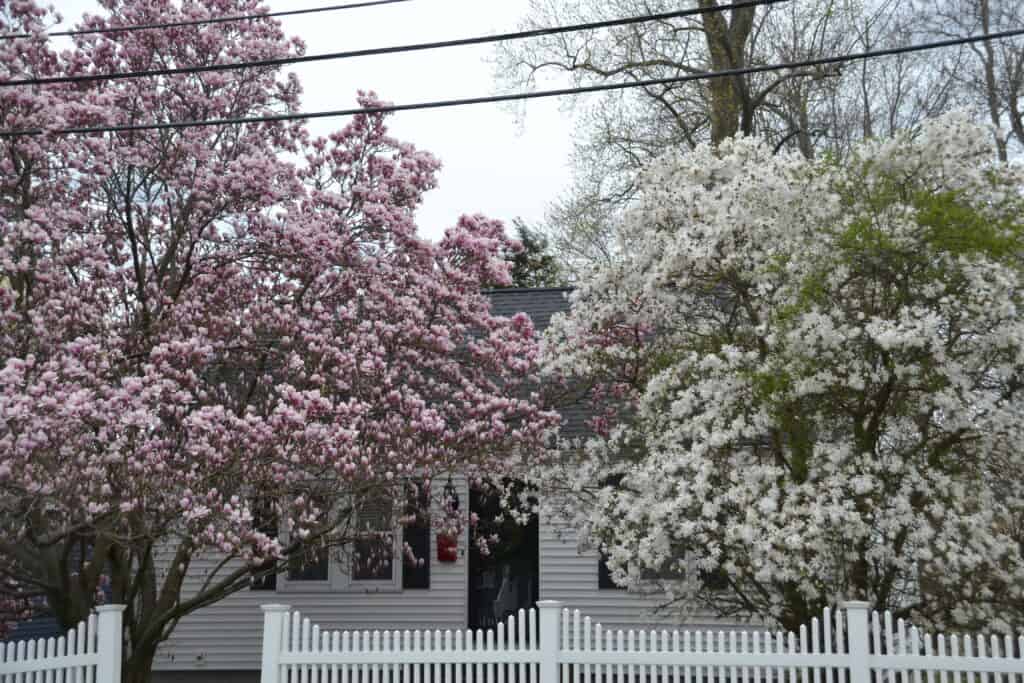Here’s what’s blooming in town this week to make your walks more enjoyable
By Laura Eisener
Today is Arbor Day in Massachusetts. The day is celebrated on different days in different states – in Massachusetts it is the last Friday of April, so it seems like a good day to look at trees, especially those blooming around town.
Sassafras (Sassafras albidum), a native tree with fragrant greenish branches, has a long history with Native Americans and was valued as one of the most valuable exports to Europe in the early days of North American exploration by Europeans. Its round buds are opening now in Saugus woods, including Pirate’s Glen, Vinegar Hill and some areas of Lynn Woods. All parts of the tree are fragrant, and it has been used for root beer, the Cajun gumbo filé and more. The leaves may be oval, mitten-shaped or three lobed, and it has brilliant fall color. It is a member of the Laurel family (Lauraceae), whose best known member may be the laurel or bay tree (Laurus nobilis) used for crowns.
April’s full pink moon bloomed in clear skies earlier this week, and Saugus is in full bloom! While many early blooming trees are wind pollinated, by this time there are quite a few bees out and about to look for showy flowers. Quite a few of the trees blooming now are members of the rose family (Rosaceae), including some of our most popular fruit trees like cherry, plum, peach (all three in the genus Prunus) and pear (Pyrus spp.). Orchards of these trees can provide some spectacular spring scenery in New England. Apples (Malus spp.) are just a little later, as most apple varieties bloom at about the same time the leaves appear, although there is sometimes some overlap of bloom time with all these species. The varieties that are bred for large and flavorful fruit often have relatives that have showier flowers but produce small and less useful fruit, which makes them less maintenance as street and park trees or in ornamental gardens. Of course, all trees provide many benefits, such as recycling oxygen through photosynthesis, providing shelter for wildlife, especially birds, and offering shade and cooling in summer. Trees provide many economic benefits to towns, such as increasing property values, buffering wind and blocking glare and lowering summer temperatures near paved areas, which otherwise would be uncomfortable due to reflected heat and sunlight.
Trees in the rose family have five petals, usually white, pink or occasionally nearly red. Once the weather becomes warm, the petals fall and cover the ground under the trees. Most need sunny locations and cannot thrive in shade and are susceptible to quite a few pests in diseases. Tent caterpillars, which build unsightly webs, are among the problems that will be seen later in the spring. Cherry and apple have several species that are popular ornamentals, and one variety of pear (Pyrus calleryana ‘Bradford’) was for many years the most popular street tree over much of North America. Known for their abundant white flowers in April and strong red fall color in late October and November, they attract bees and are often chosen as sites for bird nests. As these trees reached maturity some issues were discovered, such as breaking branches and small but numerous fruits, which often sprouted in places they were not wanted. Currently they are being considered for addition to the state’s invasive species list.
Saucer magnolias (Magnolia soulangeana) and star magnolias (Magnolia stellata) have very large flowers and are among the earliest to bloom, which can be a problem when we have a cold spell or a hard frost in April that can result in wilted and brown flowers instead of thrilling blossoms. These are attractive trees in several seasons, including winter when the fuzzy flower buds are conspicuous.
Editor’s Note: Laura Eisener is a landscape design consultant who helps homeowners with landscape design, plant selection and placement of trees and shrubs, as well as perennials. She is a member of the Saugus Garden Club and offered to write a series of articles about “what’s blooming in town” shortly after the outbreak of the COVID-19 pandemic. She was inspired after seeing so many people taking up walking.
See more photo highlights at: www.Facebook.com/advocate.news.ma



